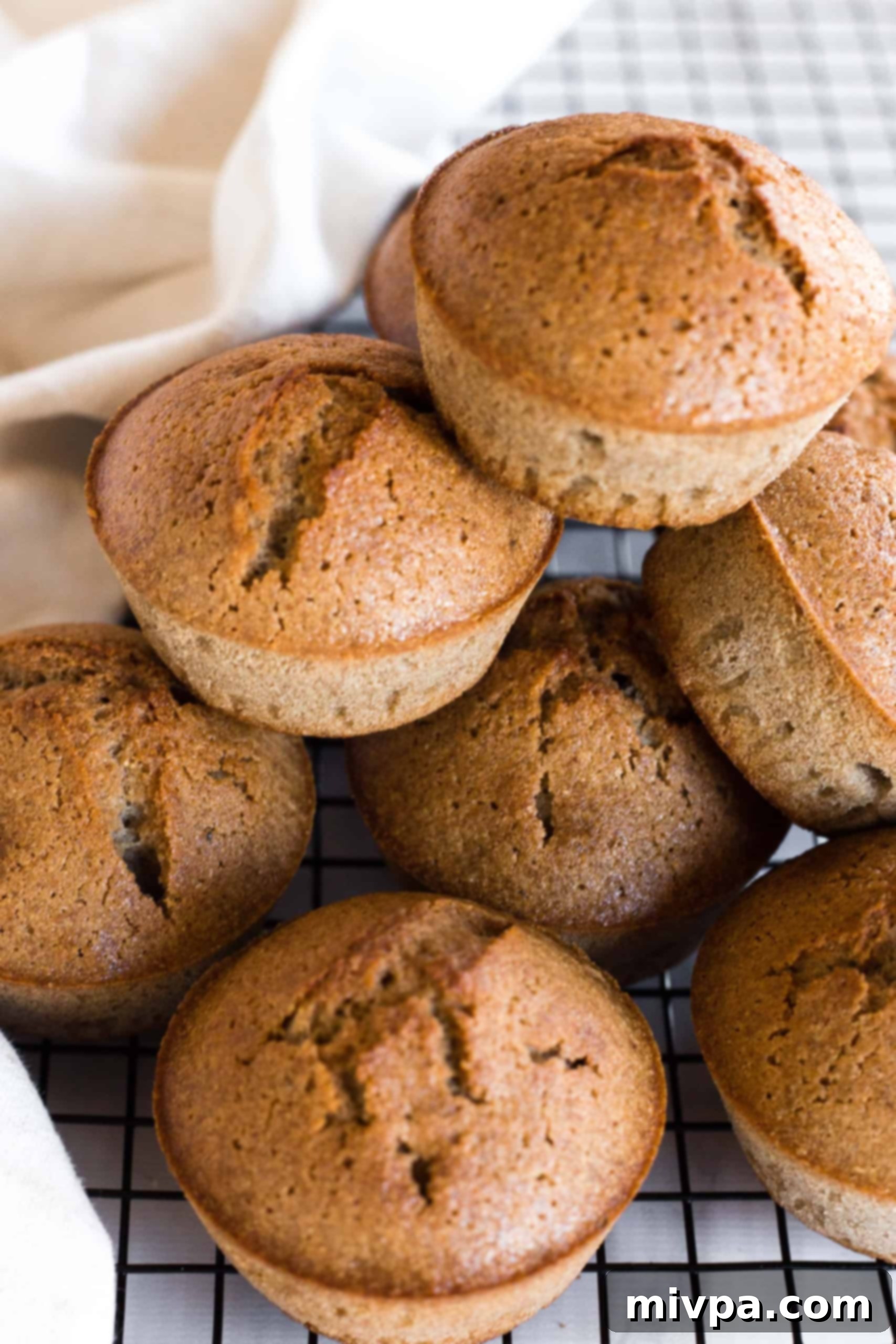Deliciously Easy Gluten-Free & Dairy-Free Buckwheat Muffins: Your New Favorite Healthy Snack!
These tender, moist, and incredibly flavorful buckwheat muffins are an absolute delight! Perfect for a quick, wholesome breakfast or a satisfying anytime snack, they come together in under an hour and are guaranteed to be a hit with the entire family. Best of all, this simple recipe is completely gluten-free and dairy-free, making them a fantastic option for various dietary needs without sacrificing taste or texture.
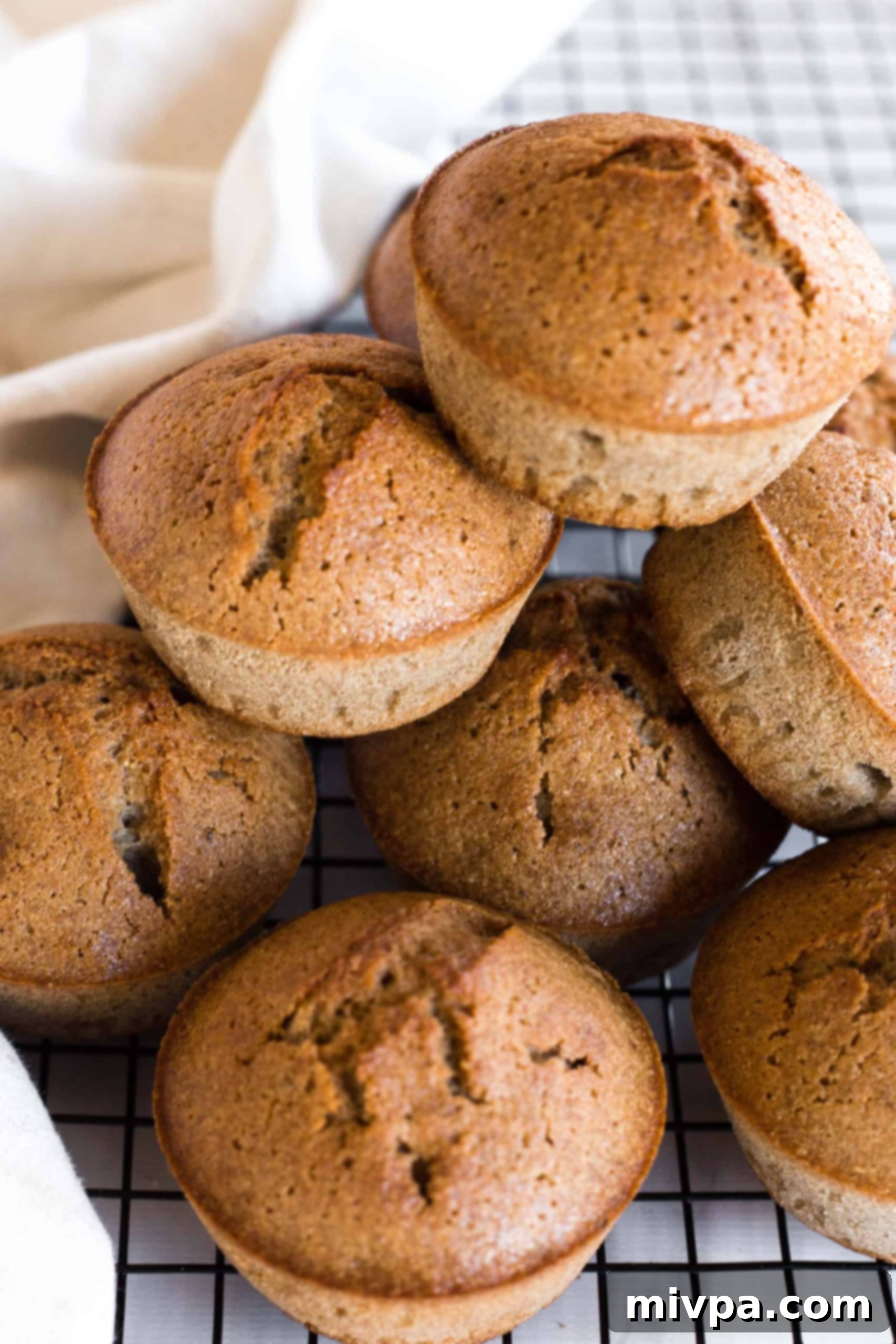
[feast_advanced_jump_to]
What Exactly is Buckwheat?
Despite its name, buckwheat is not a type of wheat, nor is it related to the grass family from which true cereals like wheat, barley, and rye originate. Instead, buckwheat is a “pseudocereal” – a term used for plants that produce seeds or fruits that are used in the same way as grains (cereals) but are botanically distinct. It’s grown for its distinctive triangular, grain-like seeds, which are highly nutritious and versatile.
Buckwheat’s classification as a pseudocereal stems from its composition of complex carbohydrates, which means it can be cooked and consumed much like a traditional grain. Think of delicious buckwheat porridge, similar to oatmeal, or using its flour in baked goods. It boasts a unique, earthy, and slightly nutty flavor profile that adds a delightful depth to any meal or recipe it’s incorporated into.
Beyond its culinary uses, buckwheat is also celebrated for its impressive nutritional benefits. It’s packed with fiber, protein, and essential minerals like magnesium, manganese, and copper. It’s also a good source of antioxidants, making it a fantastic ingredient to include in a balanced diet, especially for those seeking healthier alternatives to traditional grains.
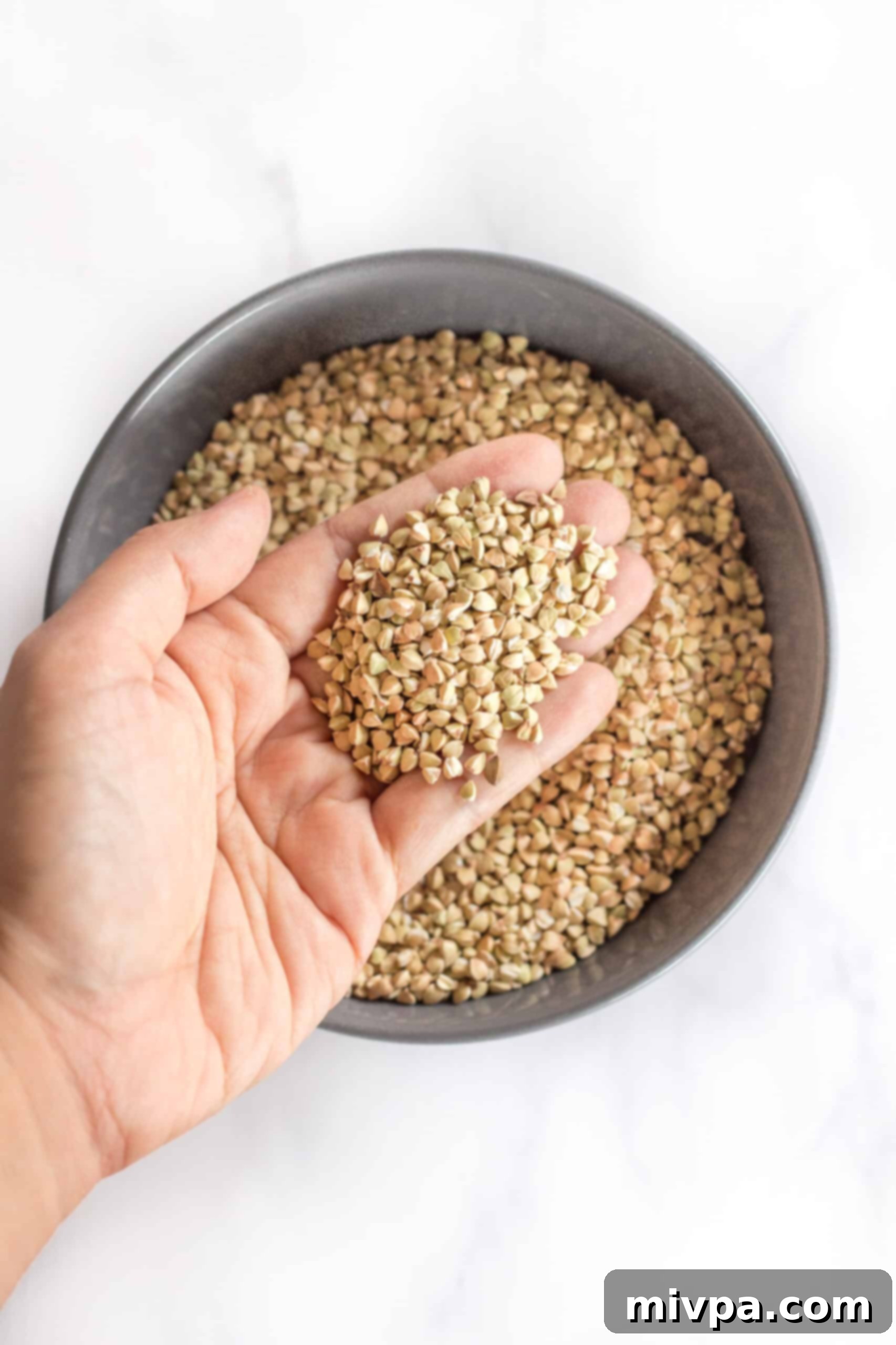
Is Buckwheat Flour Truly Gluten-Free?
A common misconception arises from the name “buckwheat,” leading many to believe it contains gluten. However, as we clarified, buckwheat is not related to wheat. This is excellent news for individuals managing celiac disease or gluten intolerance!
Buckwheat is naturally and unequivocally gluten-free. This means that its seeds, often referred to as ‘buckwheat groats,’ can be safely ground into a flour and used in a wide array of gluten-free baked goods and recipes. For anyone needing to avoid gluten, buckwheat flour offers a fantastic and nutritious alternative, allowing you to enjoy delicious treats like these muffins without worry. Always ensure you purchase buckwheat flour that is certified gluten-free to avoid any potential cross-contamination if you have a severe allergy or celiac disease.
How to Make Your Own Buckwheat Flour at Home
While you can easily purchase buckwheat flour from most health food stores or online, did you know that making your own buckwheat flour at home is surprisingly simple and cost-effective? Freshly ground flour also tends to have a more vibrant flavor.
All you need are a few basic tools: hulled buckwheat groats (preferably, as they yield a lighter colored flour), a high-speed blender or a good coffee grinder, and a fine-mesh sieve. Simply blend the groats until they reach a flour-like consistency, then sift out any larger pieces to ensure a smooth, uniform flour perfect for baking. This process allows you to control the freshness and texture of your flour, enhancing the overall quality of your baked goods.
Note: Using hulled buckwheat groats (the light-colored ones) will result in a lighter flour, which is ideal for a more delicate muffin. If you use unhulled groats, you’ll get a darker, more intensely flavored buckwheat flour, which can also be delicious but will change the color and density of your final product. Experiment to find your preference!
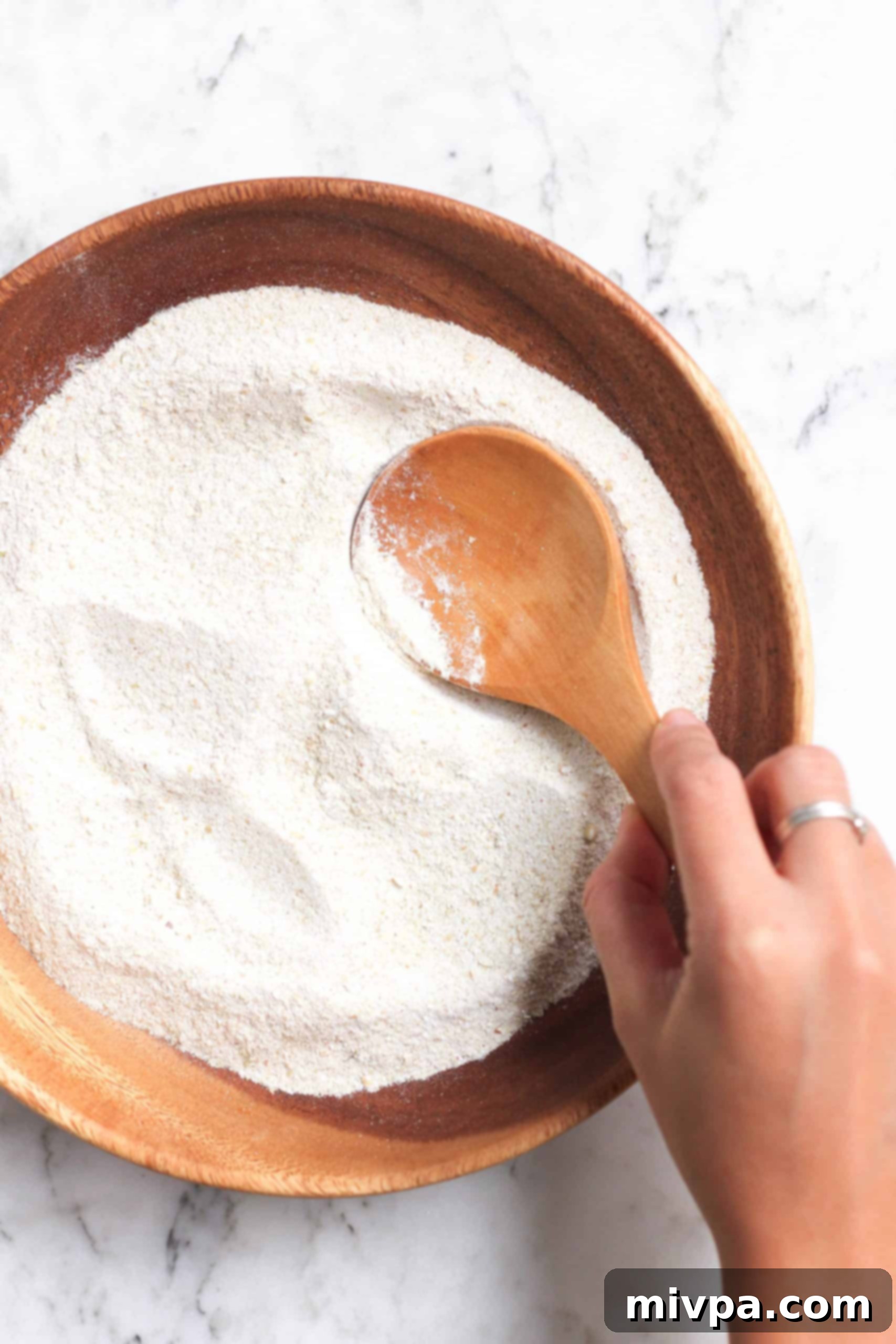
Versatile Buckwheat Muffins: Perfect for Breakfast or Any Moment
Buckwheat flour is a truly versatile ingredient, and I’ve loved experimenting with it in many recipes. From a soft, fluffy, and tender buckwheat bread to crispy buckwheat cookies, moist buckwheat banana bread, and even light buckwheat crepes, its unique nutty profile adds character to everything. You can even whip up delicious gluten-free buckwheat pancakes!
For a long time, I’ve wanted to perfect a gluten-free buckwheat muffin recipe, and finally, here it is! These muffins are a truly delicious way to kickstart your morning, offering a wholesome and satisfying start to your day. But their appeal doesn’t stop at breakfast. They are equally perfect as a quick, energizing snack to grab on the go, a delightful addition to a lunchbox, or a comforting treat with your afternoon tea. Their tender texture and subtle earthy flavor make them a crowd-pleaser any time you’re craving something sweet and wholesome.

Why You’ll Love This Buckwheat Muffin Recipe:
- Simple, Wholesome Ingredients: You won’t need to hunt for obscure items! The ingredients for these delicious buckwheat flour muffins are readily available at any local grocery store. We focus on natural, accessible components to ensure that anyone can whip up a batch without hassle.
- Effortlessly Easy to Make: This recipe is designed for simplicity. Preparing the batter is a straightforward process of mixing the wet and dry ingredients in separate bowls, then combining them. There’s no complicated technique involved, just simple stirring before dividing the batter into a muffin tin and letting your oven do the rest. It’s truly a beginner-friendly recipe that delivers impressive results.
- 100% Gluten-Free and Dairy-Free: This is arguably the best part! Our easy recipe is entirely gluten-free and dairy-free. This makes it a perfect choice for individuals with Celiac disease, gluten sensitivities, lactose intolerance, or those following a dairy-free diet. Everyone can enjoy these tender, moist muffins without any concerns about dietary restrictions, making them ideal for gatherings or family meals.
- Tender and Moist Texture: Unlike some gluten-free baked goods that can turn out dry or crumbly, these buckwheat muffins are incredibly moist and boast a delightful, tender crumb. The careful balance of ingredients ensures a perfect texture every time.
- Versatile and Customizable: While delicious on their own, these muffins are also a blank canvas for your favorite additions. From chocolate chips to fresh fruit, you can easily customize them to suit your taste, making them endlessly adaptable.

Essential Ingredients for Your Buckwheat Muffins:
Here’s a visual overview of the key ingredients required to bake this delightful batch of buckwheat muffins. Most of these are pantry staples, ensuring a fuss-free baking experience.
(For the precise measurements and quantities of each ingredient, please scroll down to the detailed printable recipe card located at the bottom of this post.)
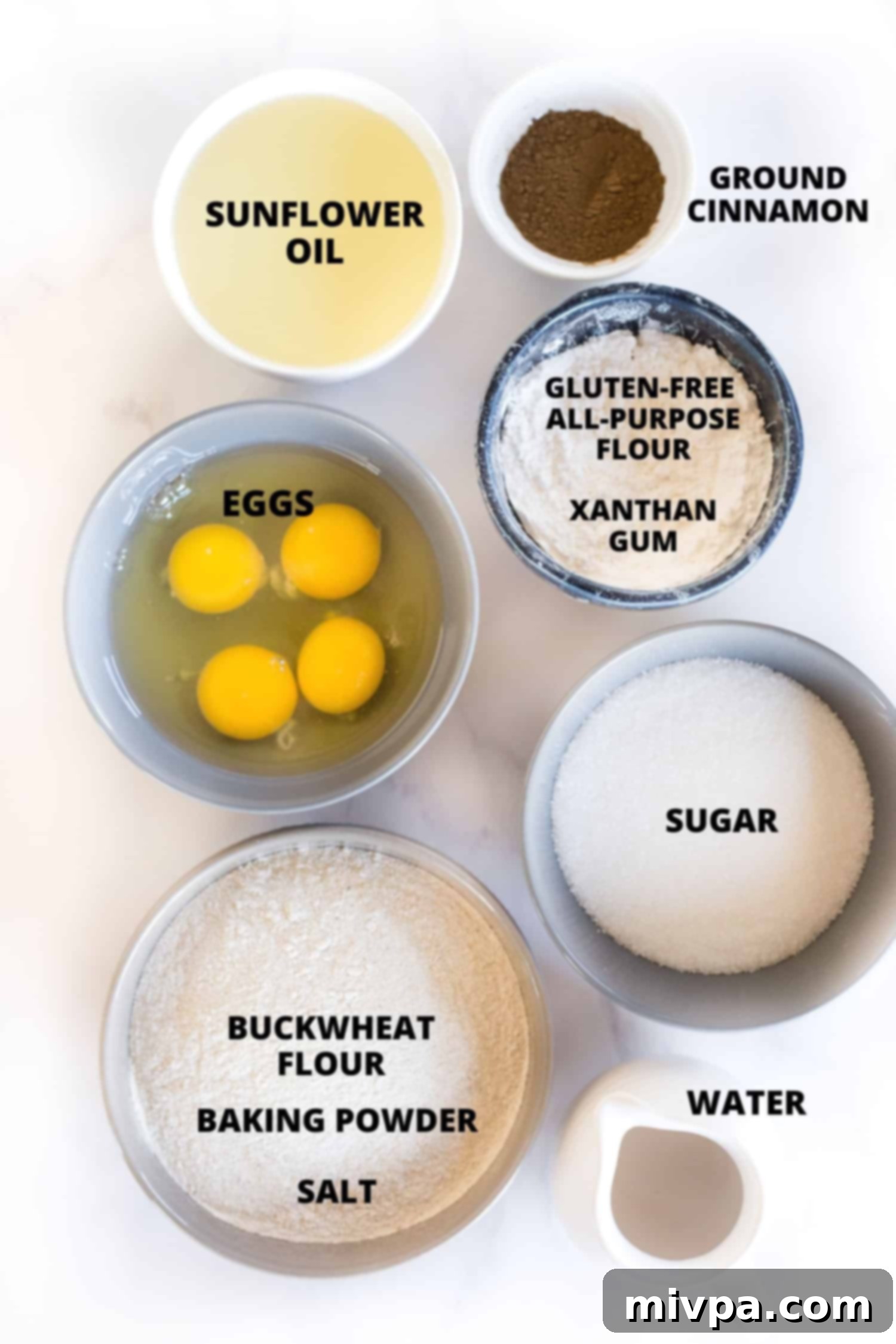
Recipe Notes & Helpful Substitutions:
Understanding the role of each ingredient and the best substitutes can help you customize this recipe to your preferences or dietary needs.
- Sunflower Oil: I personally favor sunflower oil for its neutral flavor and common availability. However, this recipe is quite forgiving, and you can easily substitute it with other mild-flavored vegetable oils such as corn oil, light olive oil, avocado oil, or even peanut oil. For a richer flavor or if you prefer an alternative, melted vegan butter or melted coconut oil will also work beautifully in equal quantities, maintaining the dairy-free aspect. If dairy is not a concern, melted regular butter or ghee can be used.
- Sugar: I’ve opted for white granulated sugar in this recipe to achieve a light and classic muffin flavor. But feel free to experiment with different sweeteners! Light brown sugar or dark brown sugar will impart a deeper, more caramel-like flavor, while coconut sugar can offer a slightly less refined sweetness with a hint of caramel. For those monitoring blood sugar levels or following a diabetic-friendly diet, I highly recommend using a 1:1 sugar substitute like granulated monk fruit sweetener, which has a zero glycemic index and won’t spike blood sugar.
- Eggs: Eggs are crucial in this recipe as they act as a primary binder, helping to hold all the ingredients together and provide structure to the muffins. They also contribute to the moisture and richness. For these reasons, I do not recommend substituting the eggs in this specific recipe to ensure the best possible outcome.
- Water: Filtered water is my go-to for its neutral taste. However, for an added layer of flavor and richness, you can absolutely substitute the water with unsweetened plant-based milk. Options like homemade almond milk, creamy cashew milk, or even full-fat coconut milk (from a carton, not a can for baking) would work wonderfully, enhancing the dairy-free profile.
- Buckwheat Flour: The star ingredient! You have the choice to either make your own buckwheat flour from hulled groats for ultimate freshness, or purchase it conveniently online or from a store. It’s important to note that for a lighter, more tender muffin texture, I use a mix of buckwheat flour and a gluten-free all-purpose flour blend. Using 100% buckwheat flour can sometimes result in a denser muffin, which some prefer, but for a classic fluffy texture, the blend is key.
- Gluten-Free All-Purpose Flour Blend: To achieve that perfect light and airy muffin texture, selecting the right gluten-free all-purpose flour blend is crucial. I strongly recommend using a high-quality blend primarily composed of lighter flours and starches, such as rice flour, tapioca starch, corn starch, or potato starch. These blends contribute to a delicate crumb. Conversely, I advise against using blends that contain heavier flours, like garbanzo bean (chickpea) flour, as these can make the muffins too dense and impart an unwanted savory flavor.
- Xanthan Gum: This ingredient is a must in gluten-free baking! Xanthan gum acts as a vital replacement for gluten, providing elasticity and binding properties that gluten-free flours naturally lack. It helps prevent crumbling and gives your muffins a desirable structure and chewiness. Do not omit it.
- Baking Powder: As the sole leavening agent in this recipe, baking powder is indispensable for ensuring your muffins rise beautifully and achieve that characteristic domed top. Always make sure your baking powder is fresh and active for the best results. If you have celiac disease or severe gluten intolerance, double-check that you’re using certified gluten-free baking powder to avoid any hidden gluten.
- Ground Cinnamon: A touch of ground cinnamon adds a wonderful warmth and aromatic depth that complements the nutty flavor of buckwheat beautifully. It elevates the muffin from simple to sublime, so I highly recommend including this pinch of spice for an extra delicious muffin!
- Salt: A small pinch of salt balances the sweetness and enhances all the other flavors in the muffins. Don’t skip it!
How to Make Easy Gluten-Free Buckwheat Muffins (Step-by-Step Guide):
Follow these simple steps to bake a batch of perfect, tender buckwheat muffins that are both gluten-free and dairy-free.
1. Preheat Oven and Prepare Muffin Tin
Begin by preheating your oven to 350°F (175°C). Next, prepare a 12-cup regular muffin tin or a silicone muffin mold by greasing it thoroughly with oil or nonstick cooking spray. Alternatively, for easier cleanup and presentation, you may line the muffin mold with paper muffin cups or paper liners.
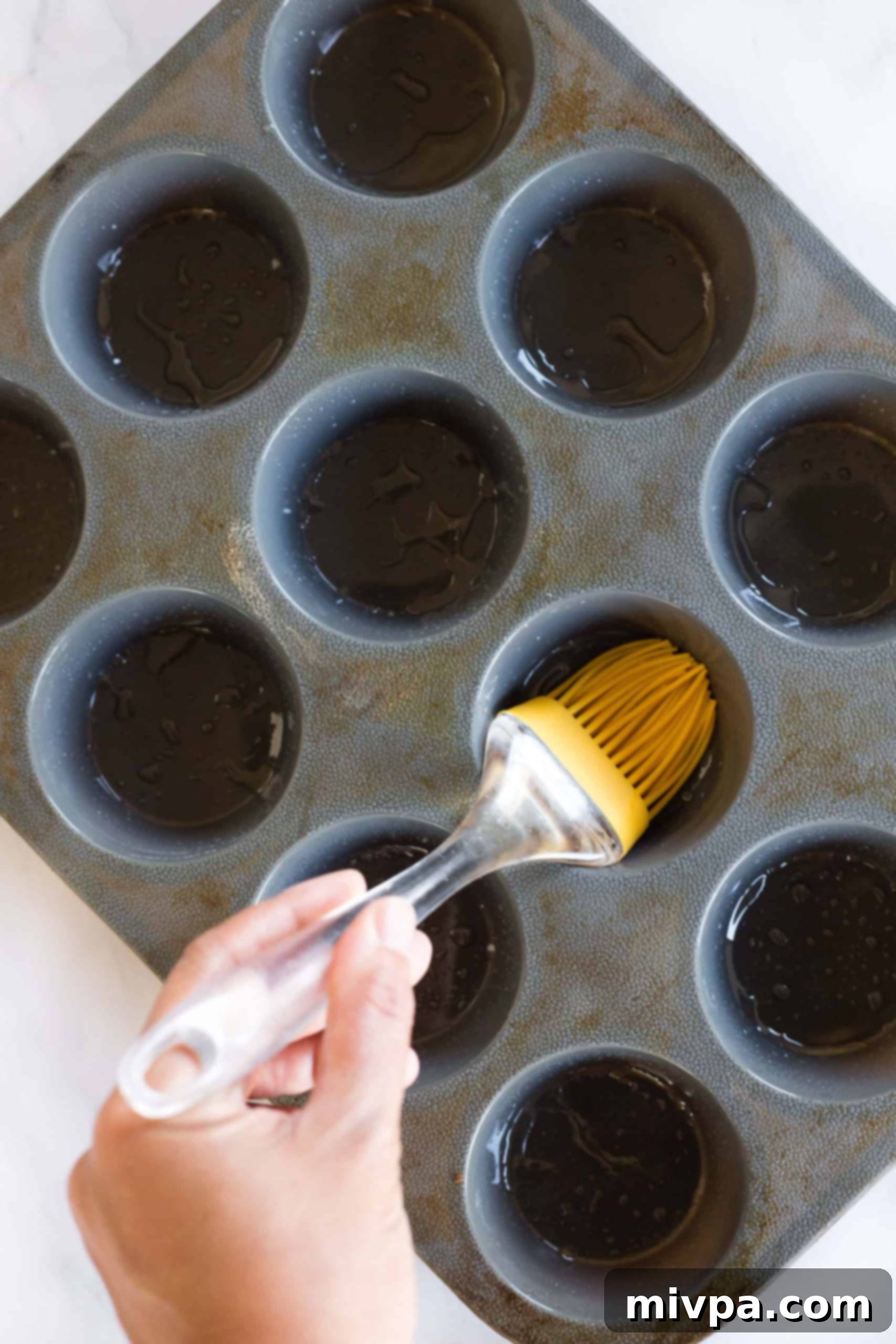
2. Combine Wet Ingredients: Beat Oil and Sugar
In a spacious mixing bowl, combine the sunflower oil and sugar. Use a whisk or a spatula to beat them together vigorously until they are well-combined and the mixture appears smooth and slightly lighter in color. This step helps to dissolve the sugar and create the base for a tender muffin.
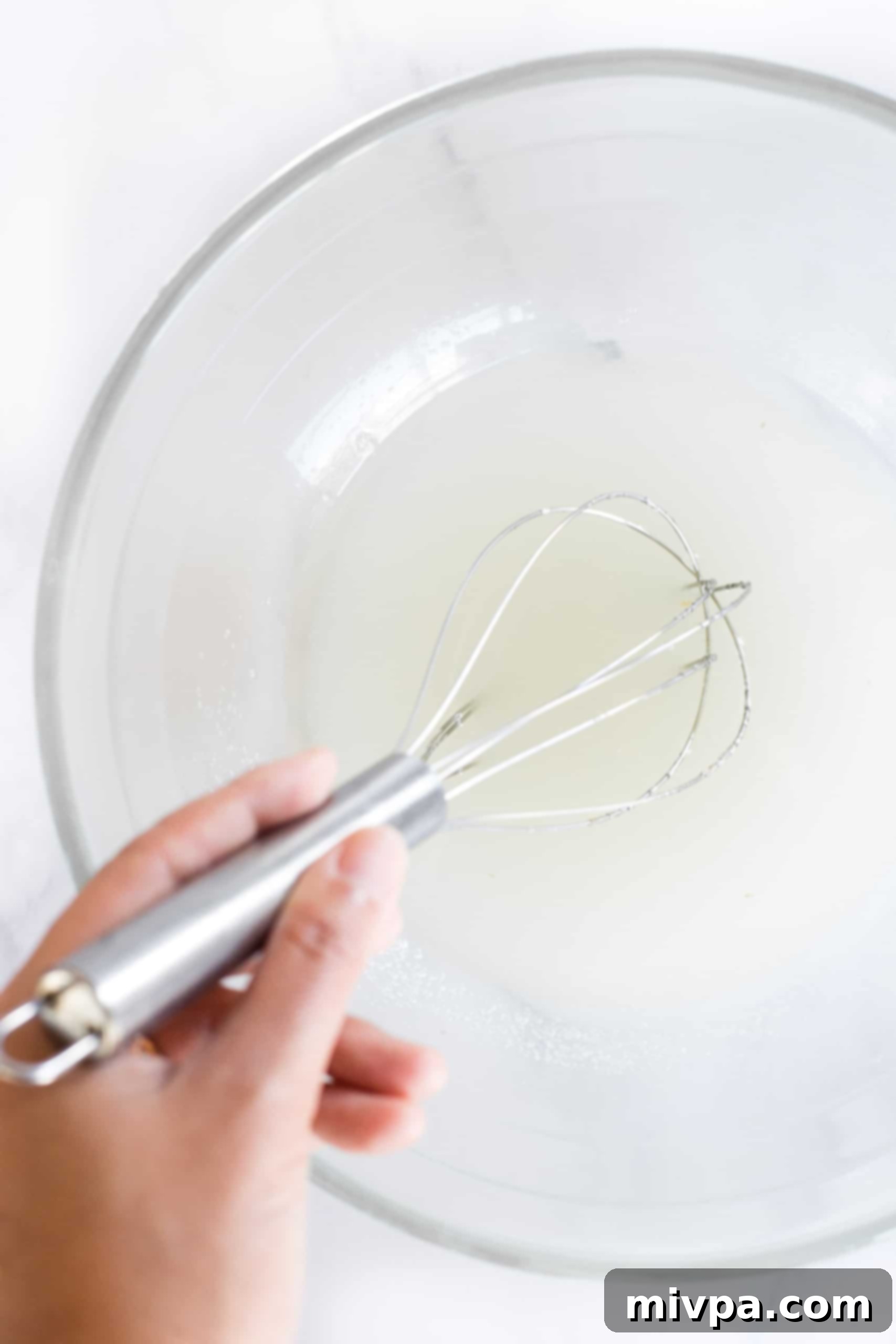
3. Incorporate Eggs and Water
To the oil-sugar mixture, add the pre-beaten eggs and the filtered water (ensuring it’s at room temperature for better incorporation). Whisk all the wet ingredients together thoroughly until they are fully combined and the mixture is uniform. This liquid base is essential for the muffin’s moisture and structure.

4. Prepare Dry Ingredients
In a separate large bowl, combine all the dry ingredients. Sift together the buckwheat flour, gluten-free all-purpose flour, xanthan gum, baking powder, a pinch of salt, and the ground cinnamon. Sifting helps to remove any lumps and ensures that all the dry components are evenly distributed, which is crucial for uniform rising and texture. Whisk these dry ingredients together thoroughly to combine them well.

5. Combine Wet and Dry Ingredients to Form Batter
Gently add the sifted flour mixture to the bowl containing the liquid ingredients. Mix everything together carefully, just until a homogeneous batter forms. Be mindful not to overmix, as this can lead to tough muffins. The batter will be quite liquid, which is normal for this recipe, ensuring a moist end product.
6. Divide Batter Evenly
Once your batter is ready, evenly divide it among the twelve cavities of your prepared muffin tin or mold. Fill each cup approximately two-thirds full, allowing room for the muffins to rise beautifully during baking.
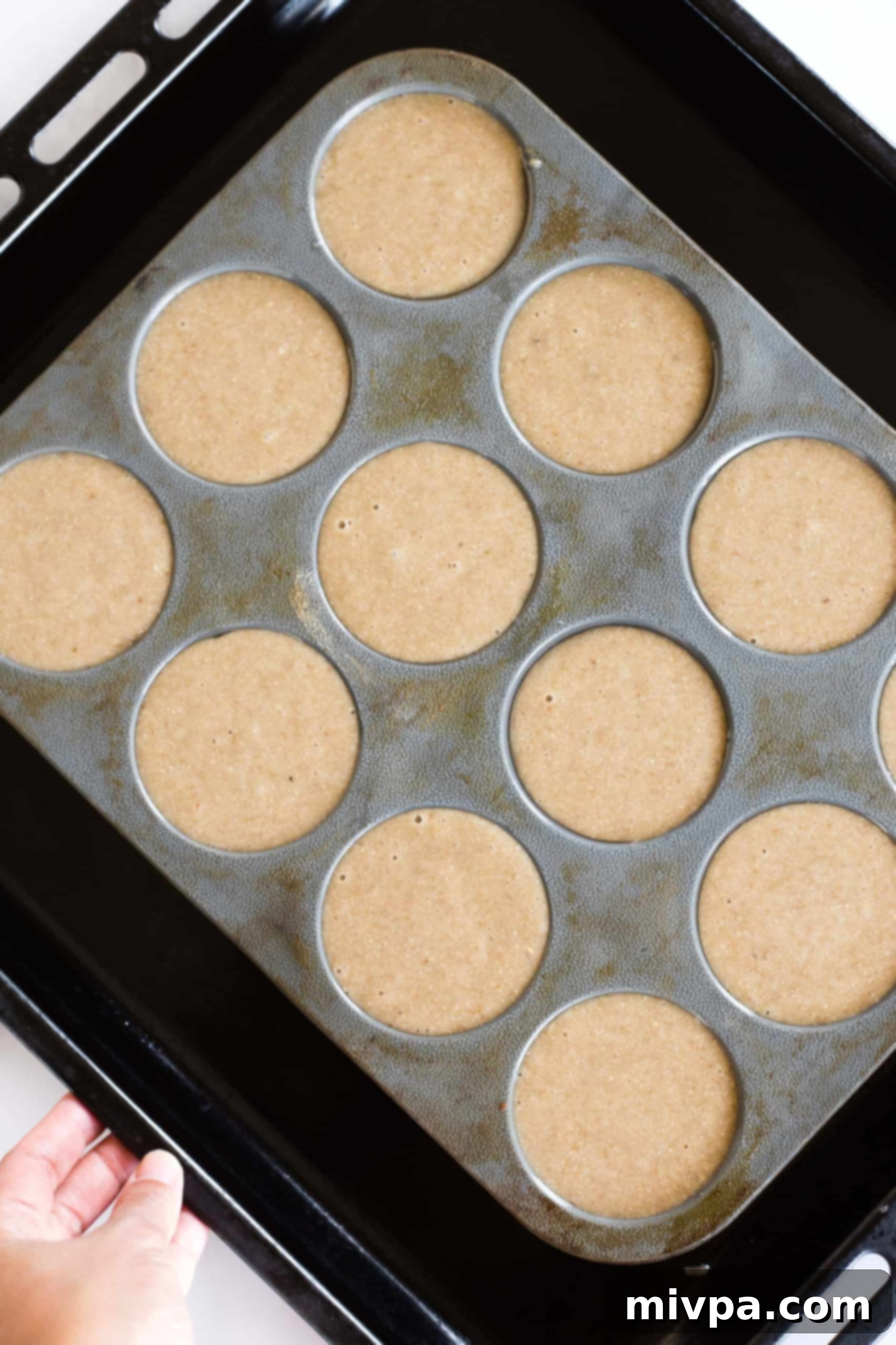
7. Bake Until Golden Brown and Domed
Place the muffin tin in your preheated oven and bake for approximately 30 to 35 minutes. Keep an eye on them; the muffins are done when they have risen, formed beautiful domes, and are golden brown on top. You can also insert a toothpick into the center of a muffin – if it comes out clean, they’re perfectly baked.
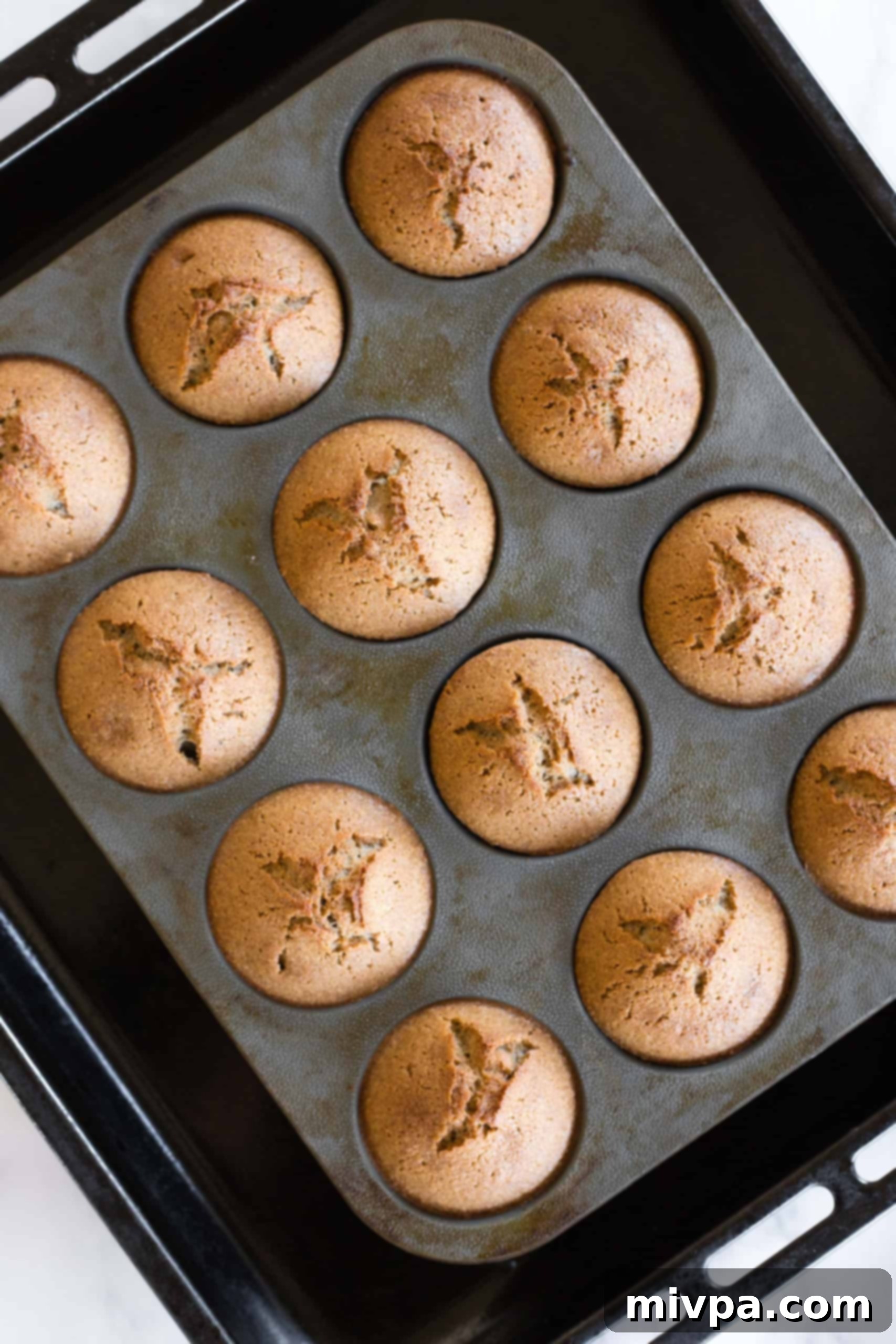
8. Cool Properly Before Enjoying
Once baked, remove the muffin pan from the oven. Let the buckwheat muffins cool in the pan for at least 5 minutes. This crucial cooling period allows them to set and makes them easier to remove without breaking. After 5 minutes, carefully transfer the muffins from the pan to a wire rack and allow them to cool completely at room temperature before serving. Enjoy your delicious, homemade gluten-free and dairy-free buckwheat muffins!
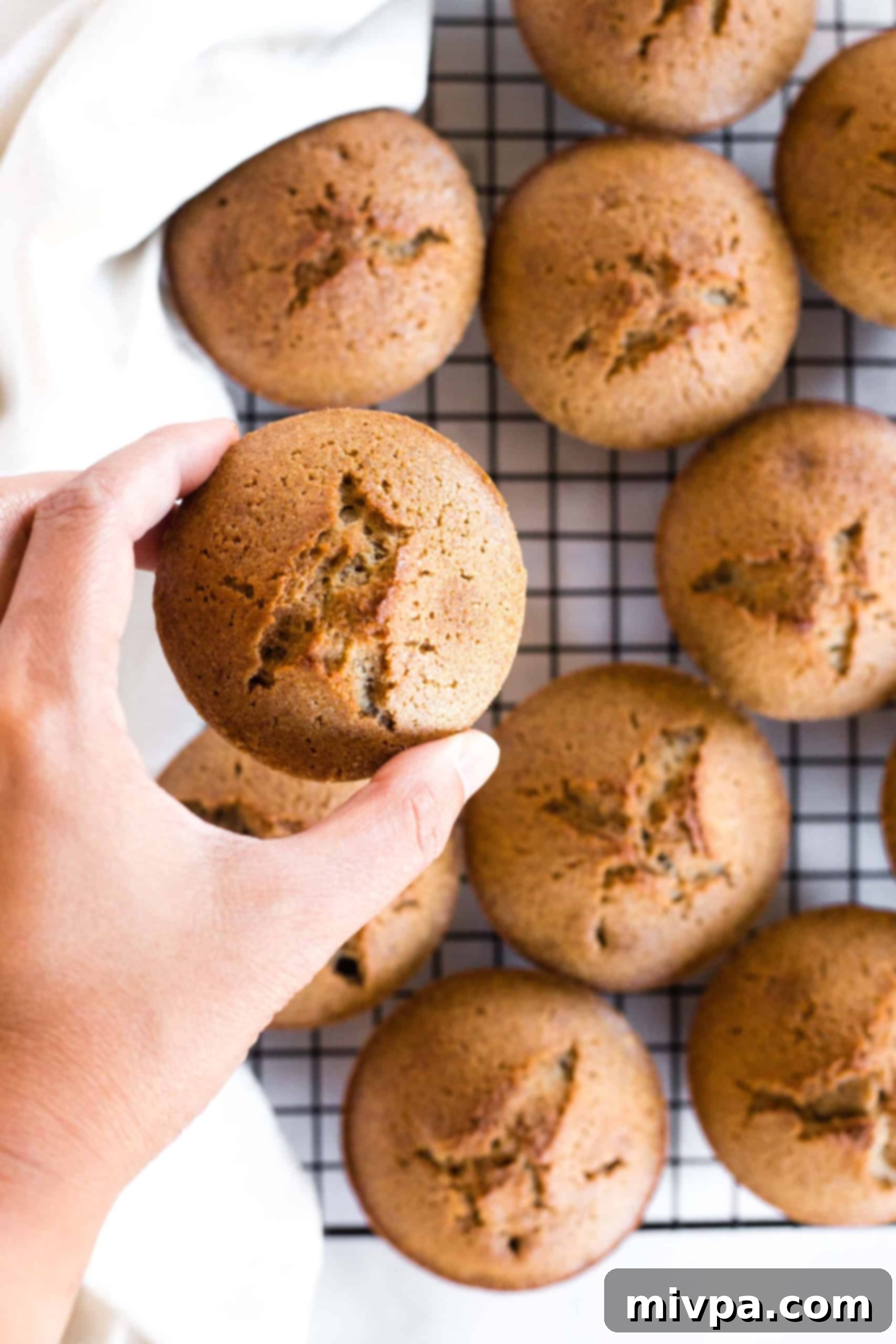
Dish by Dish Tips & Tricks for Perfect Muffins:
- Proper Storage for Freshness: To keep these gluten-free buckwheat muffins fresh, place them in an airtight container and store them in the refrigerator for up to 4 days. If you’ve baked a larger batch or want to enjoy them later, these muffins freeze beautifully! Wrap individual muffins tightly in plastic wrap, then place them in a freezer-safe bag or container. They will keep well in the freezer for up to 2 months. To enjoy from frozen, simply thaw them completely overnight in the refrigerator, and then warm them slightly in the oven or microwave for that fresh-baked taste.
- Delicious Optional Add-Ins: These buckwheat muffins are wonderfully adaptable! Feel free to customize them with your favorite additions to create new flavor profiles. Consider stirring in a handful of chocolate chips (dairy-free if needed), crunchy cacao nibs, nutritious pumpkin seeds, or some tiny chia seeds for an extra boost. For a fruity twist, add a cup of fresh or frozen blueberries to make delicious buckwheat blueberry muffins – just toss the frozen berries directly into the batter!
- Don’t Overmix: As with most muffin recipes, overmixing the batter can lead to tough muffins. Mix just until the wet and dry ingredients are combined. A few small lumps are perfectly fine!
- Room Temperature Ingredients: Using room temperature eggs and water (or plant-based milk) helps them emulsify better with the oil and sugar, creating a smoother, more uniform batter and a better texture in your finished muffins.
Common Questions About Buckwheat Muffins:
Yes, buckwheat is naturally 100% gluten-free. Despite having “wheat” in its name, it is a pseudocereal and not related to the wheat plant. It is perfectly safe for consumption by individuals with celiac disease or those with gluten intolerances or allergies.
While this recipe is dairy-free, it does use eggs. For a vegan version, you would need to replace the eggs with a suitable egg substitute, such as flax eggs (1 tbsp ground flaxseed + 3 tbsp water per egg, let sit for 5 minutes). Note that results may vary slightly in texture when substituting eggs.
Several factors contribute to moist muffins: using oil (which stays liquid at room temperature) rather than solid fats, not overmixing the batter, and not overbaking them. Following the cook time guidelines and checking for doneness with a toothpick will help you achieve perfectly moist results.
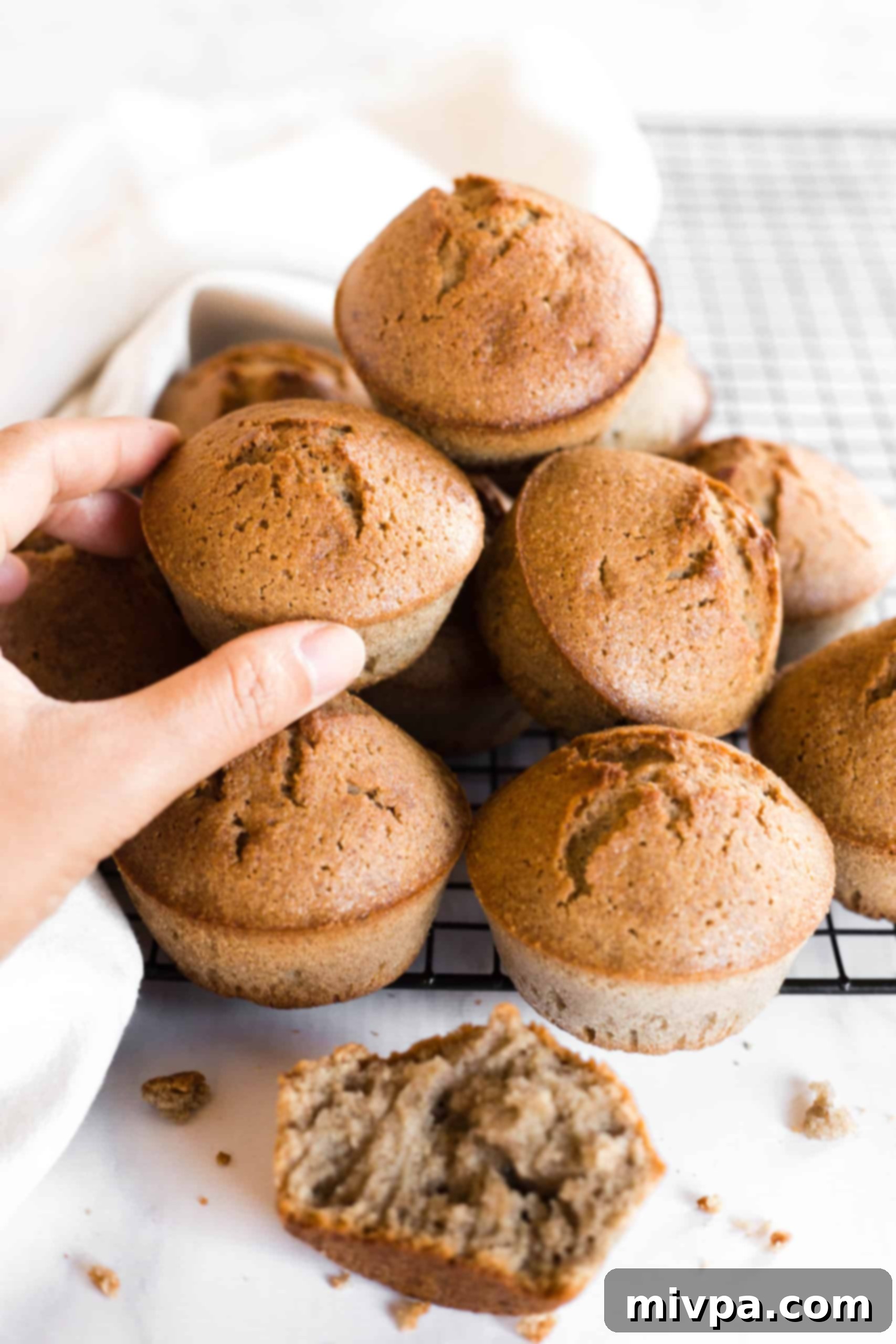
More Delicious Buckwheat Flour Recipes to Enjoy:
- Soft, Fluffy Buckwheat Bread (Gluten-Free, Dairy-Free)
- Easy Buckwheat Cookies (Gluten-Free, Dairy-Free)
- Moist Buckwheat Banana Bread (Gluten-Free, Dairy-Free)
- Easy Buckwheat Crepes (Gluten-Free, Dairy-Free)
Other Favorite Gluten-Free Muffin Recipes to Bake:
- Gluten-Free Pumpkin Banana Muffins (Dairy-Free)
- 25 Easy Gluten-Free Muffin Recipes for Anytime
- Gluten-Free Pumpkin Chocolate Chip Muffins (Dairy-Free)
- Moist Banana Blueberry Oatmeal Muffins (Gluten-Free, Dairy-Free)
P.S. If you try this fantastic recipe for gluten-free and dairy-free buckwheat muffins, I’d absolutely love for you to leave a star rating below! Your feedback is incredibly valuable, so please consider sharing a review in the comment section further down the page. I always appreciate hearing from you. Don’t forget to check out my entire Recipe Index for all the other delicious recipes on the blog. You can also follow me on Pinterest, Facebook, or Instagram for daily inspiration! And for fresh recipes delivered straight to your inbox each week, make sure to sign up for my Email List!
Print Recipe
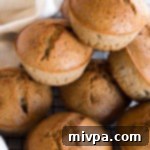
Easy Buckwheat Muffins (Gluten-Free, Dairy-Free)
5 Stars
4 Stars
3 Stars
2 Stars
1 Star
4.7 from 3 reviews
Author: Felicia Lim
Total Time: 45 minutes
Yield: 12 muffins
Diet: Gluten Free
Description
Tender and moist, a batch of these easy buckwheat muffins come together in under an hour, and make a great breakfast, or an anytime snack the whole family will love! Totally gluten-free and dairy-free too.
Ingredients
Units
Scale
- 1 cup sunflower oil
- 1 cup sugar
- 4 large eggs, beaten
- 1 cup filtered water, room temperature
- 2 cups buckwheat flour
- 1/2 cup gluten-free all-purpose flour blend
- 1/2 teaspoon xanthan gum
- 2 1/2 teaspoons gluten-free baking powder
- Pinch of salt
- 2 teaspoons ground cinnamon
Instructions
- Preheat and Grease: Preheat oven to 350F (175°C) and grease a 12-cup regular muffin tin or a silicone muffin mold. Alternatively, line with paper muffin cups.
- Beat Oil and Sugar: In a large mixing bowl, beat the sunflower oil and sugar together until well combined and smooth.
- Add Eggs and Water: Add the beaten eggs and room temperature filtered water to the oil-sugar mixture. Whisk thoroughly until all wet ingredients are fully incorporated.
- Whisk Dry Ingredients: In another large bowl, sift together the buckwheat flour, gluten-free all-purpose flour, xanthan gum, baking powder, salt, and ground cinnamon. Whisk well to ensure everything is evenly distributed.
- Combine Wet and Dry Ingredients: Add the prepared flour mixture to the bowl with the liquid ingredients. Mix gently using a spatula or spoon until a homogeneous batter forms. Be careful not to overmix; a few small lumps are perfectly fine.
- Divide Batter Between Cavities: Evenly divide the buckwheat muffin batter among the 12 cavities of your prepared muffin tin or mold, filling each about two-thirds full.
- Bake Until Golden Brown: Bake in the preheated oven for 30 to 35 minutes, or until the muffins are beautifully domed, golden brown on top, and a toothpick inserted into the center comes out clean.
- Cool Before Removing: Allow the baked buckwheat muffins to cool in the muffin pan for at least 5 minutes before carefully removing them. Transfer them to a wire rack to cool completely at room temperature before serving and enjoying.
Notes
Sunflower Oil: I like using sunflower oil because I always have a bottle of it around. You may also use other types of mild vegetable oils (such as corn oil, light olive oil, avocado oil, peanut oil etc), or melted vegan butter or melted coconut oil will work too. Alternatively, if not strictly dairy-free, you may also use melted butter or ghee in equal quantities.
Sugar: I used white sugar, but you can also use light brown sugar, dark brown sugar, or coconut sugar if you prefer. If you are diabetic or insulin-resistant, I highly recommend using granulated monk fruit sweetener (a 1:1 sugar substitute that is zero glycemic index and will not raise your blood sugar).
Eggs: Eggs are necessary to bind the ingredients together and provide structure. I do not recommend substituting the eggs in this case to ensure the best texture.
Water: I used filtered water, but you may also use unsweetened plant-based milk such as almond milk or cashew milk if you prefer, for added richness.
Buckwheat Flour: You can either make your own buckwheat flour from hulled groats or buy it online. Note that I use a mix of both buckwheat flour and a gluten-free all-purpose flour blend to create a lighter, more tender texture (using all buckwheat flour will make the muffins very dense).
Gluten-Free All-Purpose Flour: I recommend using a good-quality gluten-free all-purpose flour blend that is made up of lighter flours/starches (such as rice flour, tapioca starch, corn starch or potato starch), to ensure a lighter final texture. I do NOT recommend using a flour blend that includes heavier flours (such as garbanzo bean flour) as that will result in a heavier final texture and potentially an off-flavor.
Xanthan Gum: Xanthan gum is crucial as the replacement for gluten in gluten-free flours, providing structure and preventing crumbling. Make sure to add this in.
Baking Powder: Since baking powder is the only leavening agent used in this buckwheat muffin recipe, and is necessary for helping the batter to rise and create domes, make sure to add this in. If you are Celiac or gluten-intolerant, make sure to use certified gluten-free baking powder.
Ground Cinnamon: I like adding a pinch of ground cinnamon to add warmth and flavor – don’t leave it out because it truly makes for a more delicious muffin!
Storing: To store, place these gluten-free buckwheat muffins in an airtight container and store in the refrigerator for up to 4 days. To freeze, wrap the muffins individually in plastic wrap and then place them in a freezer-safe bag or container for up to 2 months. Let the muffins thaw completely overnight in the refrigerator before warming them up a little in the oven or microwave for best enjoyment.
- Prep Time: 10 mins
- Cook Time: 35 mins
- Category: Snacks
- Method: Baking
- Cuisine: Western
